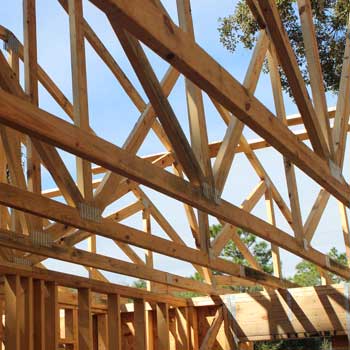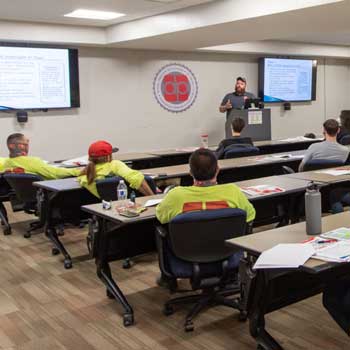Most people are familiar with the “traditional” educational path – namely graduating from high school and then pursuing a college degree. But many are not aware of the various pathways available for construction education. What does training and preparation for careers in construction look like?
To find out, we sat down with Dan Belcher, director of workforce development for NCCER. His duties include informing and updating government, workforce, industry and education sponsors about NCCER and its activities. He also assists companies, schools, and governmental agencies in implementing workforce development activities to improve the construction industry and foster the growth of the craft professional.
The four main construction training components we will be highlighting are career and technical education (CTE) in high school, industry training and apprenticeships, community college, and four-year universities.
For some students, their first experience with construction training will come in the form of career and technical education courses in their high school. Formerly called vocational education, CTE focuses on teaching direct career skills through hands-on learning. The construction component of CTE, often known as “shop class,” can give students an early feel for working with construction tools, equipment and materials.
When looking at a high school construction program, Belcher points out that they are designed to get students through NCCER Core in the first year or two and then maybe through Level 1 of a specific craft. These programs help high school students test the waters of the construction industry, while gaining valuable experience and knowledge about important construction basics such as safety. Not only are they testing the industry out, they are starting themselves on the fast track by beginning to earn NCCER credentials.

While high school CTE programs are a great start, some programs may be limited by issues such as school budget and scheduling practices. Many high schools don’t have a construction program at all, and while local magnet schools may be able to provide an alternative, transportation can be an issue. These reasons are why it’s important for school districts and communities to invest in CTE and look at career education and academic education as necessary complements.
“You are short-sighted saying there is a CTE side and an educational side. They have to merge together to make a successful student and a successful program,” said Belcher. “That also means you need the industry to step in and say this is what we need schools to produce.”
Whether you experienced craft training during your high school years or not, many construction companies provide training themselves, either through in-house programs or through paying for the trainees to attend technical or community college.
For in-house training, one of the most popular models is apprenticeships. The concept of apprenticeship, which can be traced back to the craft guilds during the Middle Ages, transferred from Europe to North America and became prominent during the rise in unionization back in the 1920s and ’30s.
In an apprenticeship, a student learns from an experienced master of a given craft. Modern construction apprenticeships feature a split between classroom learning and on-the-job training (OJT). Official apprenticeship programs are either federally registered or state-registered, although in most cases the standards and requirements are the same. Belcher says that the main difference between a registered apprenticeship program and non-registered training programs is how progress of the trainee is tracked and recorded.

Depending on the program and the craft, an apprenticeship usually takes around 2-4 years, at about 2,000 hours per year. If an apprentice has already started earning NCCER credentials through a previous CTE program, they already have a head start.
One of the top advantages of apprenticeships and industry training is the ability to earn as you learn. Apprentices get paid for work done during OJT time, often done during the day, while the classroom components are done at night. As apprentices advance in their training, their pay rates advance as well.
Upon successful completion of about four years of training and job experience, and often accompanied by passing a certification or licensing exam, craft professionals shed the apprentice label and earn the title of journeyman.
While high school CTE and unaffiliated community college programs tend to teach construction in more of a broad sense, construction companies tend to be more narrowly focused in their in-house training programs to fit the specific needs of the company.
Community colleges and two-year associate’s degrees offer a versatile option for construction education.
This route can work as that broad, introductory funnel for individuals who did not get career and technical education in high school. If a CTE program was not available at a student’s high school, community college can help form a foundation of the needed knowledge such as the math and science aspects of construction. This is a great option for students who are still exploratory and don’t want to jump straight into industry training with company, or for young people who want to learn craft skills while still having more of a traditional college experience.
Belcher used the analogy that community college can often act as a “minor leagues” for construction – students can learn a craft, and upon completion of the program local contractors can hire them. Some companies have agreements with the community college where they can hire students to a sort of futures contract, provided they stay in school through the completion of the degree.
Community colleges also often work collaboratively with contractors and construction companies by helping facilitate their apprenticeship programs. Rather than teach in-house, those companies can send trainees to the community college and take advantage of their dedicated teaching staff and classroom facilities for the knowledge-based component of the apprenticeship. As Belcher noted, using a community college partnership like this can provide some stability; while a building project may only take 1-2 years to complete, the community college remains in place and able to instruct regardless of the status of the OJT project.
While most construction craft careers don’t require a four-year bachelor’s degree, there are opportunities in the industry for those who wish to pursue the university route.
Construction management, engineering and architecture are all construction careers that require a four-year degree. This route offers that full college experience for the student while preparing them for positions in management and design.
But while these are good careers, Belcher reminds that there is a growing shortage of craft professionals. He believes students would be better served by learning a craft and getting some real experience in the industry – while maybe pursuing the management-level degrees at a later time, perhaps with the financial support of the company.
“Who is going to build all the stuff you designed, if we don’t have the craft people who are able to do that?” Belcher observed.
Belcher also pointed out that the construction industry isn’t just comprised of the builders and designers for construction projects. Construction companies also have information technology, human resources, legal, marketing and public relations, and other departments like any other type of company that draw employees from various education backgrounds. Even if you’ve never picked up a hammer, you might still have a place in the construction industry.
Perhaps more than any other field, the various education and training pathways in construction are interconnected. A craft professional may go through all four of the training components highlighted here at some point in their career, and not necessarily in the order you would expect. At the end of the day, it’s all about continuously learning.
During his time serving as a principal at a school in Texas, Belcher recalls that he told students who graduated to never stop learning – you always have to keep moving forward. In construction there really is no stopping point because in this industry, there are “on- and off- ramps” at many junctures.
“Fill your toolbelt with skills,” Belcher said, “and never stop progressing.”
Looking to find construction training near you? Use the newly revamped NCCER Find a Training Center tool to locate accredited facilities and programs nearby.